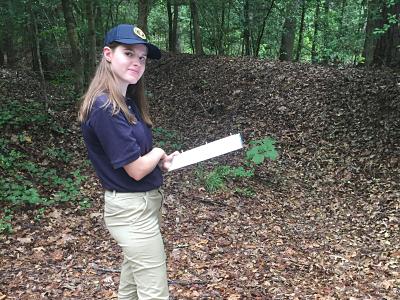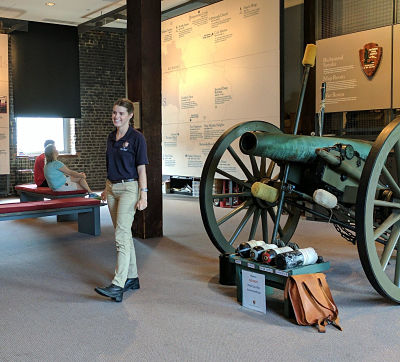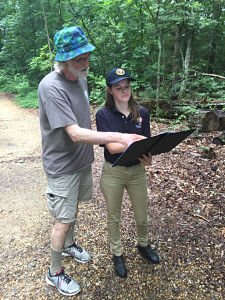
Greetings from Richmond National Battlefield Park!
Despite the massive number of bugs, sweltering heat, and possible ghosts, working for the Richmond National Battlefield Park has been an absolute dream. As the Nau Center’s summer intern at the park, I primarily work at two of our thirteen sites: our main visitor center at Historic Tredegar and at the Cold Harbor Battlefield. Additionally, I spend two days a week working on my research project, which focuses on Virginia women during the secession crisis and subsequent convention.
During the Civil War, Tredegar served as the largest iron works for the Confederacy and produced about 50% of the cannon used during the war. Today, Historic Tredegar features exhibits focusing on Richmond during the war and the Union army’s two campaigns that attempted to capture the city. However, our main interpretive tool is a 12-pound Napoleon cannon, made at Tredegar in February 1863. We use it for both formal and informal interpretation. Even though we spent two weeks in interpretive training, the difference between formal and informal interpretation is subjective and thus different for each ranger. I consider a formal talk to be much more theatrical and include a demonstration on firing the cannon; everything else is informal. So far this summer, I have completed two formal cannon talks and countless informal ones. When doing a cannon talk, I tend to discuss the background of Tredegar, the different types of ammunition used by Civil War-era artillerists, the eight man artillery team itself, and any other relevant information. I really enjoy giving informal cannon talks because they are incredibly interactive and most visitors enjoy learning more about the cannon.

While I thoroughly enjoy working at Historic Tredegar, my favorite site to work at is Cold Harbor. There is a sharp contrast between visitors at Tredegar and at Cold Harbor; most visitors at Tredegar are “grazers” in that they look around but aren’t really interested in talking in depth about the war. However, at Cold Harbor, most visitors are very interested in the war and want to know more. We often get visitors trying to find out more about their ancestors who fought at either Gaines Mill or Cold Harbor. I love that our visitor center includes exhibits for both the Seven Days Battles (1862) and the Overland Campaign (1864) as these exhibits display the contrasts between these two campaigns that took place on the same battlefield. While working at Cold Harbor, I also give a walking battlefield tour. While my tour focuses on the memory of the battle, I also discuss not only the battle itself but also the Confederate earthworks and the Union high command. While it seems like a lot on paper, in practice my tour flows really well and I’m really happy with it.

All in all this internship has been absolutely amazing. I have learned so much about interpretation from truly the best interpreters and I have met some amazing visitors who share my passion and love for the Civil War. Being able to talk about what I love to people that are interested is a great experience for me and I’m so excited for the rest of the summer!
